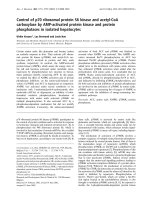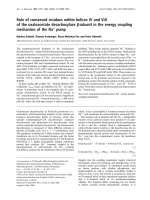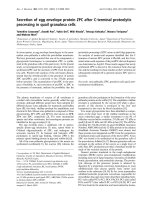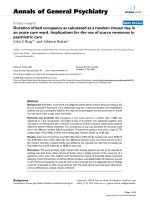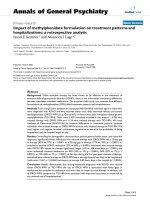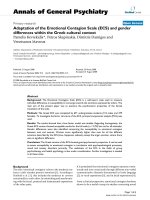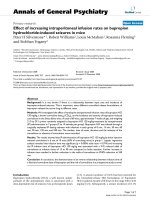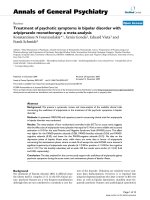Báo cáo y học: "Lack of Correlation between Severity of Clinical Symptoms, Skin Test Reactivity, and Radioallergosorbent Test Results in Venom-Allergic Patients" pptx
Bạn đang xem bản rút gọn của tài liệu. Xem và tải ngay bản đầy đủ của tài liệu tại đây (193.53 KB, 6 trang )
62
There is an understandable tendency on the part
of patients (and probably also physicians) to
assume that there is a clinical correlation between
(1) the degree of skin test reactivity to an allergen
on intradermal or epicutaneous prick testing for
immediate hyposensitivity and (2) the level of
clinical responsiveness to that allergen. A previ-
ous study examined this relationship for inhalant
allergens and found a correlation between the
severity of clinical symptoms and the degree of
skin test reactivity (assessed by the size of the
Original Article
Lack of Correlation between Severity of
Clinical Symptoms, Skin Test Reactivity,
and Radioallergosorbent Test Results in
Venom-Allergic Patients
R.J. Warrington, MB, BS, PhD, FRCP(C)
Abstract
Purpose: To retrospectively examine the relation between skin test reactivity, venom-specific immunoglob-
ulin E (IgE) antibody levels, and severity of clinical reaction in patients with insect venom allergy.
Method: Thirty-six patients (including 15 females) who presented with a history of allergic reactions to
insect stings were assessed. The mean age at the time of the reactions was 33.4 ± 15.1 years (range,
4–76 years), and patients were evaluated 43.6 ± 90 months (range, 1–300 months) after the reactions.
Clinical reactions were scored according to severity, from 1 (cutaneous manifestations only) to 3 (ana-
phylaxis with shock). These scores were compared to scores for skin test reactivity (0 to 5, indicating
the log increase in sensitivity from 1 µg/mL to 0.0001 µg/mL) and radioallergosorbent test (RAST) lev-
els (0 to 4, indicating venom-specific IgE levels, from undetectable to > 17.5 kilounits of antigen per
litre [kUA/L]).
Results: No correlation was found between skin test reactivity (Spearman’s coefficient = 0.15, p =.377)
or RAST level (Spearman’s coefficient = 0.32, p =.061) and the severity of reaction. Skin test and RAST
scores both differed significantly from clinical severity (p < .05), but there was a significant correlation
between skin test reactivity and RAST score (p =.042). There was no correlation between skin test reac-
tivity and time since reaction (Spearman’s coefficient = 0.18, p =.294) nor between RAST and time since
reaction (r = 0.1353, p = .438). Elimination of patients tested more than 12 months after their reaction
still produced no correlation between skin test reactivity (p = .681) or RAST score (p =.183) and the sever-
ity of the clinical reaction.
Conclusion: In venom-allergic patients (in contrast to reported findings in cases of inhalant IgE-mediated
allergy), there appears to be no significant correlation between the degree of skin test reactivity or lev-
els of venom-specific IgE (determined by RAST) and the severity of the clinical reaction.
R.J. Warrington—Departments of Medicine and
Immunology, University of Manitoba, Winnipeg,
Manitoba
Correspondence to: Dr. Richard Warrington, Section of
Allergy and Clinical Immunology, GC319, 820 Sherbrook
Street, Winnipeg, MB R3A 1R9; e-mail:
DOI 10.2310/7480.2006.00006
Symptoms, Skin Tests, and Radioallergosorbent Tests in Venom Allergy — Warrington 63
response) or the levels of specific immunoglobu-
lin E (IgE) antibody (measured by radioaller-
gosorbent test [RAST]).
1
Other studies of venom
and food allergies have not shown such a corre-
lation.
2–5
In this analysis, investigators determined
the relation between the above parameters for
patients with a clinical history of immediate hyper-
sensitivity to venoms of stinging insects by cate-
gorizing the clinical severity of the reaction to a
sting, the levels of skin test reactivity to increas-
ing concentrations of venoms, and specific IgE lev-
els measured by RAST.
Methods
Thirty-six patients who were referred to the Allergy
and Clinical Immunology Clinic at the Health
Sciences Centre in Winnipeg for possible
immunotherapy after having a systemic reaction
to an insect sting were assessed. The group con-
tained 15 females, and the mean age was 33.4 ±
15.1 years (4–76 years). The patients were eval-
uated 43.6 ± 90 months (median, 5.5 months;
range, 1–300 months) after the reaction.
The patients were assessed in the following
parameters:
1. Severity and characteristics of the clinical
reaction, rated as follows
6
:
a. Cutaneous manifestations only (hives,
pruritus, or peripheral angioedema)
b. Upper- or lower-airway obstruction
c. Anaphylaxis with hypotension and
shock necessitating resuscitation
2. Time (months) between the clinical reac-
tion and the skin testing and RAST (done
at the time of skin testing)
3. Skin test results after intradermal testing
with venom in 10-fold dilutions from
1.0 µg/mL (positive-rated 1 on the skin
testing scale) to 0.0001 µg/mL (positive-
rated 5 on the skin testing scale). Results
of skin testing were compared to a posi-
tive (histamine 1.0 mg/mL) and negative
(saline) control, and a positive response
had a wheal ≥ 5 mm and flare ≥ 10 mm.
4. RAST (carried out in the Department of
Clinical Chemistry, Health Sciences
Centre, with Pharmacia assays)
No assays were carried out by Pharmacia
CAP System RAST, and no patients suffered from
significant gastrointestinal symptoms or car-
diac/respiratory arrest.
Results were categorized as follows:
Negative: 0 (< 0.35 kilounits of antigen per
litre [kUA/L])
Low: 1 (0.35–0.70 kUA/L)
Medium: 2 (0.7–3.5 kUA/L)
High: 3 (3.5–17.5 kUA/L)
Very high: 4 (> 17.5 kUA/L)
Statistical Analysis
Comparison of the three parameters (skin test,
RAST, and clinical severity) was performed by
Kruskal-Wallis one-way analysis of variance
(ANOVA) on ranks, with
SigmaStat 2.0 statisti-
cal software (Jandel Scientific). Correlation coef-
ficients were determined by Spearman’s rank
order correlation, again with
SigmaStat software.
Power was assessed by PS power and sample size
calculation software (Dupont and Plummer, free-
ware, 1997). Graphic analysis was done with
DPlot 2.0.0.3 software (HydeSoft Computing).
Results
Of the 36 patients assessed, 16 had a reaction
with only cutaneous manifestations, 13 had upper-
or lower-airway obstruction, and 6 had anaphylaxis
with cardiovascular collapse. None had significant
gastrointestinal symptoms.
Twenty-seven patients were assessed within
12 months of their reaction, and the remaining nine
patients were seen 14 to 300 months after the
reaction to venom (Table 1).
As determined by the scoring system described
previously, the mean score for skin tests was
2.806 ± 1.064 standard deviation (SD), the mean
64 Allergy, Asthma, and Clinical Immunology / Volume 2, Number 2, Summer 2006
score for RAST was 2.857 ± 0.974, and the mean
score for clinical severity was 1.833 ± 1.028.
By ANOVA, the skin test score was signifi-
cantly different from the clinical severity score
(
p < .05, power = 0.988). The RAST score was also
significantly different from the clinical severity
score (
p < .05, power = 0.996). However, the
RAST score did not differ significantly from the
skin test score (
p > .05).
As determined by Spearman’s rank order cor-
relation for data not normally distributed, there was
a significant correlation between skin test score and
RAST score (
r = 0.346, p = .042, power = 0.626)
but no correlation between clinical severity and
either skin test score (
r = 0.0957, p = .576) or
RAST score (
r = 0.246, p =.152). These results are
shown graphically in a three-dimensional repre-
sentation in Figure 1, where it can be seen that the
Table 1 Demographics of Patient Population
Clinical Months since
Number Sex Age (yr) Skin Test RAST Reaction Reaction
1F47341 1
2M333 11 2
3 F 14 4 3 2 204
4 M 21 1 2 2 10
5F41031 2
6 F 49 3 2 1 14
7 M 25 1 3 1 84
8M214 43 1
9 M 4 4 4 3 240
10 F 20 3 3 1 4
11 M 18 2 3 1 5
12 F 23 5 N/A 1 276
13 M 26 3 1 2 2
14 F 33 4 4 2 1
15 F 46 2 2 1 12
16 M 49 4 3 2 30
17 M 59 2 3 2 2
18 F 36 2 3 2 12
19 M 37 3 3 2 18
20 M 28 4 4 1 300
21 F 40 3 3 1 3
22 M 6 3 1 1 3
23 M 33 2 2 1 276
24 F 46 2 3 1 3
25 M 35 2 2 3 6
26 M 41 3 3 3 6
27 F 76 1 4 3 1
28 M 24 4 4 2 1
29 M 16 2 2 2 3
30 F 35 3 2 1 1
31 F 42 3 4 2 2
32 M 29 3 4 2 12
33 M 28 3 1 6 6
34 F 20 3 3 2 2
35 M 46 4 3 1 12
36 M 56 3 4 3 12
RAST = radioallergosorbent test.
clinical severity score tends to increase at lower
RAST scores and in the middle range of skin test
scores.
There was no correlation between skin test
reactivity and time since reaction (
r = 0.18,
p = .294) or RAST score and time since reaction
(
r = 0.183, p = .438).
Even if patients who were tested more than 12
months after their reaction were excluded, there
was still no correlation between skin test reactiv-
ity (
p = .681) or RAST score (p = .183) and the
severity of the clinical reaction.
Discussion
At this time, there are three methods by which
allergy to venom from stinging insects can be
assessed: (1) determination of the clinical sever-
ity of the reaction, (2) skin tests to measure reac-
tivity, and (3) RAST or CAP System assay to
measure specific IgE. From a linear thinking per-
spective, it might be assumed (excluding loss of
reactivity with time as a factor) that a correlation
exists between these three parameters; this does
not, however, appear to be the case.
Patrizzi and colleagues evaluated skin tests and
estimations of specific IgE antibodies by RAST
in patients with bee-sting allergy.
7
The results cor-
responded in 82% of the patients. Hoffman com-
pared RAST and skin test results for five venoms
in 60 patients with histories of stinging-insect
allergy; 48 patients with positive skin test results
showed an 88% correlation of RAST and skin
test scores.
8
Egner and colleagues reported that the
level of IgE antibody to venom does not reliably
reflect the severity of the last reaction to a sting
in patients with double positive reactivity to stings
both from honeybees and from
Vespula species.
9
Mosbech, in a comparative study of venom-
allergic patients, found a positive correlation
(
p < .05) between the results of skin-prick tests and
specific IgE against venoms. For patients allergic
to yellowjacket stings, there was also a correlation
between the severity of symptoms after the sting
and the size of the skin-prick test reaction to
venom.
2
In contrast, Nittner-Marszalska and col-
leagues found that for patients with allergy to the
venom of insects of the order Hymenoptera, there
was no correlation between the size of the skin test
reaction, the class of venom-specific IgE level
(by fluorescent allergosorbent technique [FAST]),
and the results of basophil histamine release. In
addition, no relation was found between the results
of these tests and the severity of the sting reactions
as measured on the Mueller scale.
3
In this analysis of 36 patients with immediate
hypersensitivity reactions to stinging-insect ven-
oms, no correlation was found between the degree
of skin test reactivity or RAST score and the
severity of the clinical reaction. The absence of a
significant correlation persisted when individuals
who were assessed more than 12 months after
their clinical reaction were excluded from the
analysis. A correlation was found between the
degree of skin test reactivity and venom-specific
IgE levels measured by RAST.
The fact that skin test reactivity and specific
IgE levels measured by RAST are not predictors
of the clinical severity of a reaction is apparently
not unique to venom allergy. Rosario and Vilela
found that when using quantitative skin-prick
tests with an average endpoint allergen concen-
tration of 50 allergen units (AU) on atopic asth-
matic patients, the mean wheal diameter was
not significantly greater for severely asthmatic
patients than for mildly asthmatic patients.
4
In
patients with nut allergy, Clark and Ewan
5
found
Symptoms, Skin Tests, and Radioallergosorbent Tests in Venom Allergy — Warrington 65
Figure 1 Three-dimensional plot of skin test, RAST,
and clinical severity scores of 36 patients with sting-
ing-venom allergy (as a surface plot).
66 Allergy, Asthma, and Clinical Immunology / Volume 2, Number 2, Summer 2006
no correlation between skin-prick test wheal
size and the graded severity of the worst reac-
tion for all nuts combined or for peanut, hazel-
nut, almond, and walnut. For the CAP System
specific IgE levels, there was no correlation for
all nuts, so the size of SPT or CAP System lev-
els did not predict between minor urticaria and
anaphylaxis.
These results indicate that specific IgE level
as assessed by either skin testing or serum IgE is
only one determining parameter in the induction
of anaphylaxis and that other factors must play a
role. Such factors could be mast-cell mass, mast-
cell stability, concomitant medications, number of
stings or amount of venom injected, and levels of
blocking antibodies. Although it is tempting to
assume so, the size of the skin test reaction to an
allergen or the level of specific IgE does not nec-
essarily predict clinical reactivity.
In contrast to the above studies, Souille and
colleagues
1
assessed 59 asthmatic children by
skin-prick tests, RAST (specific IgE), and
bronchial provocation with common inhalants.
They found a significant connection between the
results of the three tests. However, the concordance
level was only moderate, i.e., not greater than
68%. In comparison with bronchial provocation,
prick testing and RAST respectively yielded
numerous false-positive and false-negative results.
This is perhaps not surprising, given the problem
of allergen sensitization without clinical reactiv-
ity and the reduced sensitivity of RAST when
compared with skin testing. In this study, the neg-
ative predictive value of skin-prick tests was con-
sidered satisfactory, and the most discriminatory
threshold for the positive RAST result was the
class-3 response. This would suggest that corre-
lation between the magnitude of skin-prick tests
or RAST and bronchial challenge was not good.
van der Linden and colleagues reported on
insect-sting challenge of 324 subjects with a pre-
vious anaphylactic reaction to yellowjacket and
honeybee stings and found that a recurrence of ana-
phylaxis was observed in 25% of those sensitive
to yellowjacket stings and 52% of those sensitive
to honeybee stings.
10
Even more striking were the
findings of van Halteren and colleagues, who
described 348 patients with a previous history of
anaphylaxis to stings and with mild or no symp-
toms on in-hospital sting challenge; 129 of these
subjects subsequently were accidentally stung in
the field, and 110 had only local reactions whereas
6 patients experienced serious manifestations.
11
Therefore, previous history of a severe response
to a sting is not predictive of a subsequent serious
reaction to accidental sting challenge. Meanwhile,
two-thirds of individuals who die from a sting
reaction have no previous history of their allergy.
12
Conclusion
Allergic reactivity is a complex phenomenon that
is not explainable simply on the basis of the pres-
ence of immunoglobulin E antibodies. The diffi-
culty is to devise methods of determining who
among individuals with equivalent levels of sen-
sitization is at risk of a serious reaction.
References
1. Souille B, et al. Bronchial provocation tests in
59 asthmatic children. Comparison with skin tests
and serum allergens. Rev Mal Respir 1987;4:
225–30.
2. Mosbech H. Insect allergy. A comparative study
including case histories and immunological para-
meters. Allergy 1984;39:543–9.
3. Nittner-Marszala M, et al. Evaluation of diag-
nostic value of skin test, venom specific IgE
antibodies and basophil histamine release test in
Hymenoptera allergy. Pneumonal Alergol Pol
1993;61:346–51.
4. Rosario NA, Vilela MM. Quantitative skin prick
tests and serum IgE antibodies in atopic asth-
matics. J Investig Allergol Clin Immunol
1997;7:40–5.
5. Clark AT, Ewan PW. Interpretation of tests for
nut allergy in one thousand patients, in relation
to allergy or tolerance. Clin Exp Allergy
2003;33:1041–5.
6. Ring J, et al. History and classification of ana-
phylaxis. Novartis Found Symp 2004;257: 6–16.
7. Patrizzi R, et al. Comparison of skin tests and
RAST for the diagnosis of bee–sting allergy.
Allergy 1979;34:249–56.
Symptoms, Skin Tests, and Radioallergosorbent Tests in Venom Allergy — Warrington 67
8. Hoffman DR. Comparison of the radioaller-
gosorbent test to intradermal skin testing in the
diagnosis of stinging insect venom allergy. Ann
Allergy 1979;43:211–3.
9. Egner W, et al. The frequency and clinical sig-
nificance of specific IgE to both wasp (Vespula)
and honey-bee (Apis) venoms in the same patient.
Clin Exp Allergy 1998;28:26–34.
10. van der Linden PW, et al. Insect-sting challenge
in 324 subjects with a previous anaphylactic reac-
tion: current criteria for insect venom
hypersensitivity do not predict the occurrence
and severity of anaphylaxis. J Allergy Clin
Immunol 1994;94:151–9.
11. van Halteren HK, et al. Hymenoptera sting chal-
lenge of 348 patients: relation to subsequent
field stings. J Allergy Clin Immunol
1996;97:1058–63.
12. Pumphrey R. Anaphylaxis: can we tell who is at
risk of a fatal reaction? Curr Opin Allergy Clin
Immunol 2004;4:285–90.
